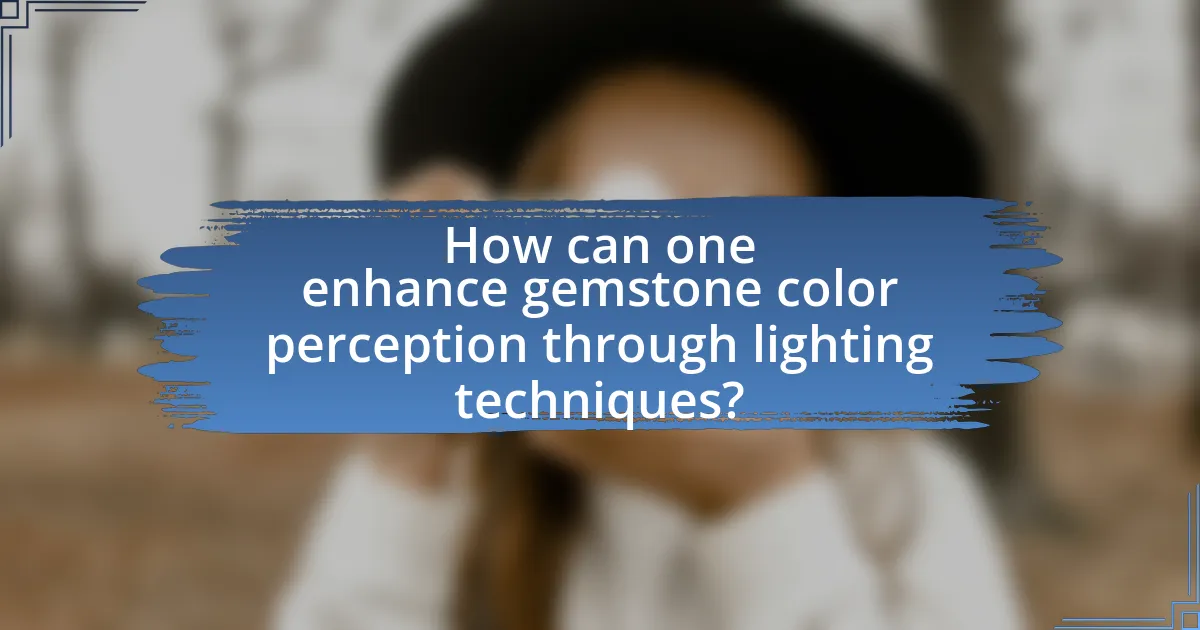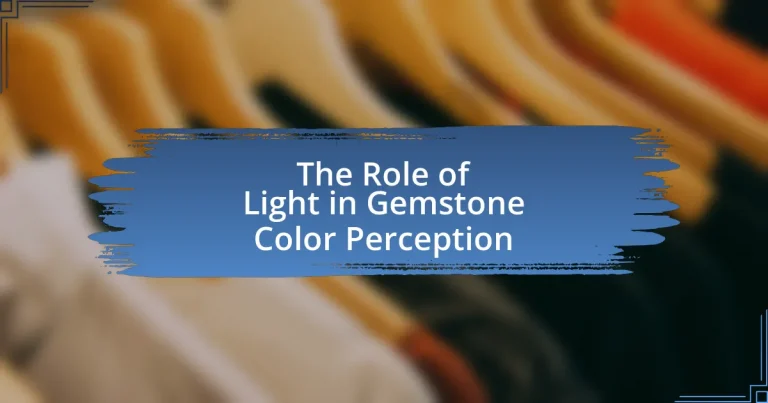The article focuses on the critical role of light in gemstone color perception, detailing how light interacts with gemstones to influence their perceived colors. It explains the processes of absorption, reflection, and refraction, which determine how gemstones display their hues under various lighting conditions. The article also examines the impact of different light sources, such as natural sunlight and artificial lighting, on gemstone appearance, as well as the significance of light for gemologists in assessing quality and value. Additionally, it discusses practical tips for evaluating gemstone colors effectively under different lighting scenarios.

What is the Role of Light in Gemstone Color Perception?
Light plays a crucial role in gemstone color perception by influencing how colors are seen and interpreted by the human eye. The interaction of light with a gemstone’s surface and internal structure determines the wavelengths that are absorbed and reflected, which ultimately defines the color that is perceived. For instance, a gemstone may appear blue due to the absorption of other wavelengths while reflecting blue light. Additionally, factors such as the type of light source (natural sunlight versus artificial light) and the angle of observation can significantly alter the perceived color of a gemstone. Studies in optics confirm that the spectral composition of light directly affects color perception, highlighting the importance of light in the visual experience of gemstones.
How does light influence the color we see in gemstones?
Light influences the color we see in gemstones primarily through the processes of absorption, reflection, and refraction. When light strikes a gemstone, certain wavelengths are absorbed by the material while others are reflected or transmitted, determining the perceived color. For example, a ruby appears red because it absorbs most wavelengths except for red, which it reflects. The specific crystal structure and chemical composition of the gemstone also play critical roles in how light interacts with it, affecting the color we observe. This phenomenon is supported by the principles of optics, where the interaction of light with matter dictates color perception in various materials, including gemstones.
What are the different types of light sources that affect gemstone color?
The different types of light sources that affect gemstone color include natural sunlight, incandescent light, fluorescent light, and LED light. Natural sunlight provides a full spectrum of light, which allows for the most accurate color representation of gemstones. Incandescent light, with its warm tones, can enhance the appearance of certain colors but may distort others. Fluorescent light tends to have a cooler tone and can make some gemstones appear more vibrant, while LED light varies widely in color temperature and can either enhance or diminish the perceived color of gemstones depending on its specific spectrum. Each light source interacts differently with the gemstone’s properties, influencing how colors are perceived by the observer.
How do variations in light intensity impact gemstone appearance?
Variations in light intensity significantly impact gemstone appearance by altering their color, brilliance, and overall visual appeal. Gemstones exhibit different hues and saturation levels under varying lighting conditions; for instance, a diamond may appear more vibrant and sparkly in bright light, while it can look dull in low light. This phenomenon occurs due to the way light interacts with the gemstone’s surface and internal structure, affecting how colors are perceived. Research indicates that gemstones can reflect and refract light differently based on intensity, which influences the observer’s perception of their beauty and value.
Why is understanding light important for gemologists?
Understanding light is crucial for gemologists because it directly influences how gemstones are perceived in terms of color, brilliance, and overall appearance. Gemologists rely on the principles of light behavior, such as reflection, refraction, and absorption, to evaluate and classify gemstones accurately. For instance, the way light interacts with a gemstone can enhance or diminish its color, which is essential for determining its quality and value. Studies have shown that different lighting conditions can alter the appearance of a gemstone, making it vital for gemologists to understand these effects to provide accurate assessments and recommendations to clients.
How does light interaction with gemstones affect their valuation?
Light interaction with gemstones significantly affects their valuation by influencing their color, brilliance, and overall appearance. The way light enters, reflects, refracts, and disperses within a gemstone determines its visual properties, which are critical in assessing quality and desirability. For instance, gemstones like diamonds exhibit brilliance due to their high refractive index, which enhances their sparkle and perceived value. Additionally, the phenomenon of pleochroism in certain gemstones, such as tanzanite, allows them to display different colors when viewed from different angles, further impacting their market value. Studies have shown that gemstones with superior light performance, such as those that exhibit vibrant colors and high levels of brilliance, command higher prices in the market, underscoring the direct correlation between light interaction and gemstone valuation.
What role does light play in gemstone identification and classification?
Light is crucial in gemstone identification and classification as it influences how colors and optical properties are perceived. The interaction of light with a gemstone determines its color, brilliance, and transparency, which are essential characteristics for distinguishing between different types of gemstones. For instance, the refractive index, which measures how much light bends when entering a gemstone, varies among different stones, aiding in their identification. Additionally, phenomena such as pleochroism, where a gemstone displays different colors when viewed from different angles, rely on light’s behavior. These optical properties are fundamental in gemology, as they provide reliable criteria for classification and authenticity verification.

What are the scientific principles behind light and color perception in gemstones?
The scientific principles behind light and color perception in gemstones involve the interaction of light with the gemstone’s material properties, including absorption, reflection, and refraction. When light strikes a gemstone, certain wavelengths are absorbed while others are reflected, determining the color that is perceived. For instance, a ruby appears red because it absorbs all wavelengths except for red, which is reflected to the observer’s eye. Additionally, the refractive index of the gemstone influences how light bends as it enters and exits the material, further affecting color perception. This phenomenon is supported by the principles of optics, which explain how light behaves in different mediums, and the specific crystal structure of gemstones, which dictates their unique optical characteristics.
How do gemstones absorb and reflect light?
Gemstones absorb and reflect light through their unique crystal structures and chemical compositions. The absorption of specific wavelengths of light occurs due to the electronic transitions within the atoms of the gemstone, which depend on the material’s properties. For instance, the presence of trace elements can alter the absorption spectrum, leading to the gemstone’s color. Reflection occurs when light hits the surface of the gemstone, and the angle of incidence affects how much light is reflected versus refracted. The refractive index, a measure of how much light bends when entering the gemstone, also plays a crucial role in determining the overall appearance. This interaction of absorption and reflection is fundamental to how we perceive the color and brilliance of gemstones.
What is the significance of refractive index in gemstone color perception?
The refractive index is significant in gemstone color perception because it determines how light interacts with the gemstone, affecting its brilliance and color appearance. A higher refractive index typically results in greater light bending, which enhances the gemstone’s sparkle and can intensify its color. For example, diamonds have a high refractive index of about 2.42, contributing to their exceptional fire and brilliance, while lower refractive index gemstones may appear duller. This optical property directly influences how colors are perceived by the human eye, as the way light is refracted and reflected within the gemstone can alter the wavelengths of light that are ultimately seen.
How does the cut of a gemstone influence its interaction with light?
The cut of a gemstone significantly influences its interaction with light by determining how light enters, reflects, and refracts within the stone. A well-executed cut maximizes brilliance and fire by optimizing the angles at which light interacts with the gemstone’s facets. For example, the ideal cut for diamonds, known as the “Ideal Cut,” is designed to reflect light back to the observer’s eye, enhancing the stone’s sparkle. Conversely, a poorly cut gemstone may allow light to escape through the bottom or sides, resulting in a dull appearance. This relationship between cut and light interaction is supported by gemological studies, which show that the quality of a gemstone’s cut can affect its perceived value and aesthetic appeal.
What are the effects of different lighting conditions on gemstone color?
Different lighting conditions significantly affect gemstone color perception. Natural light, incandescent light, and fluorescent light each influence how colors are seen due to variations in color temperature and spectrum. For instance, natural daylight enhances the brilliance and saturation of gemstones, making colors appear more vibrant, while incandescent light can warm colors, often making them appear richer but sometimes less accurate. Fluorescent light, on the other hand, can create a cooler tone, which may alter the perceived hue of certain stones. Studies have shown that gemstones can exhibit different color appearances under these varying light sources, impacting their overall aesthetic and value in jewelry.
How does natural light differ from artificial light in terms of gemstone appearance?
Natural light differs from artificial light in gemstone appearance primarily due to its spectrum and intensity. Natural light, which includes sunlight, has a balanced spectrum that enhances the true colors and brilliance of gemstones, allowing for better color differentiation and sparkle. In contrast, artificial light sources, such as incandescent or fluorescent bulbs, often emit limited spectra that can distort or diminish the perceived color and luster of gemstones. For example, incandescent light tends to emphasize warmer tones, while fluorescent light can make colors appear cooler or washed out. This difference in light quality significantly impacts how gemstones are viewed, as studies have shown that gemstones can appear more vibrant and true to their natural color under daylight conditions compared to artificial lighting.
What are the best lighting conditions for viewing gemstones?
The best lighting conditions for viewing gemstones are natural daylight or a daylight-simulating light source. Natural daylight provides a full spectrum of light, which enhances the color and brilliance of gemstones, allowing for accurate color perception. Studies show that gemstones exhibit their true colors under daylight conditions, as artificial lighting can distort hues and reduce the visibility of inclusions. For example, a gemstone may appear more vibrant and true to its color when viewed in sunlight compared to incandescent or fluorescent lighting, which can alter the appearance of the stone.

How can one enhance gemstone color perception through lighting techniques?
One can enhance gemstone color perception through specific lighting techniques by utilizing natural daylight or high-quality artificial light sources that mimic daylight. Natural daylight, particularly during midday, provides a full spectrum of light that reveals the true colors of gemstones, enhancing their vibrancy and depth. High-quality artificial lights, such as LED lights with a color temperature of around 5000K to 6500K, can also effectively replicate this effect, making colors appear more vivid and true to life. Studies have shown that the spectral composition of light significantly influences color perception; for instance, a study published in the Journal of Gemmology indicates that gemstones exhibit different color characteristics under varying light sources, confirming that optimal lighting can enhance their visual appeal.
What lighting techniques can be used to showcase gemstone colors effectively?
To effectively showcase gemstone colors, techniques such as backlighting, diffused lighting, and spotlighting can be utilized. Backlighting enhances transparency and reveals the internal characteristics of gemstones, making colors appear more vibrant. Diffused lighting softens shadows and reduces glare, allowing for a more even distribution of color across the surface. Spotlighting focuses light on specific areas, highlighting the brilliance and fire of the gemstone. These techniques are supported by the principles of light interaction with materials, which indicate that the way light is directed and diffused can significantly alter color perception in gemstones.
How can the use of filters enhance the perception of gemstone colors?
The use of filters can enhance the perception of gemstone colors by selectively altering the wavelengths of light that reach the observer’s eye. Filters can enhance specific colors by blocking out certain wavelengths, allowing the desired hues of the gemstone to appear more vibrant and pronounced. For example, a blue filter can intensify the blue tones in a sapphire, making it appear more vivid by reducing the influence of competing colors. This effect is supported by the principles of color theory, which state that the perception of color is influenced by the surrounding light conditions and the wavelengths that are transmitted or absorbed by the material.
What are the best practices for displaying gemstones in retail settings?
The best practices for displaying gemstones in retail settings include utilizing proper lighting, organizing gemstones by color and type, and ensuring security measures are in place. Proper lighting enhances the color and brilliance of gemstones, with natural light or LED lights being ideal for showcasing their true hues. Organizing gemstones by color and type allows customers to easily navigate the display and appreciate the variety, which can increase sales. Additionally, implementing security measures, such as display cases with locks or surveillance cameras, protects valuable inventory while maintaining an inviting shopping atmosphere. These practices are supported by retail studies indicating that well-lit and organized displays significantly improve customer engagement and purchasing decisions.
What practical tips can help in assessing gemstone color under different lighting?
To accurately assess gemstone color under different lighting, use natural daylight as a primary light source, as it provides a balanced spectrum that reveals true colors. Additionally, compare the gemstone under various artificial light sources, such as incandescent, fluorescent, and LED lights, since each type can alter the perception of color due to their different color temperatures. Observing the gemstone from multiple angles can also help identify color variations and undertones that may not be visible from a single viewpoint. This approach is supported by the understanding that color perception is influenced by the light source, as demonstrated in studies on color theory and visual perception.


